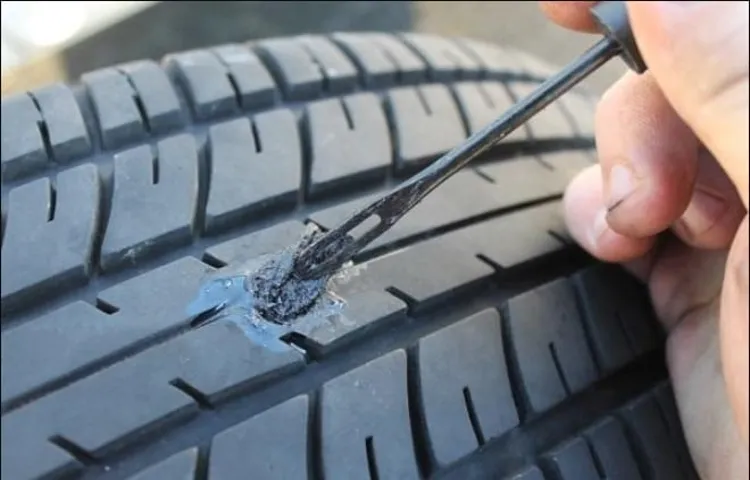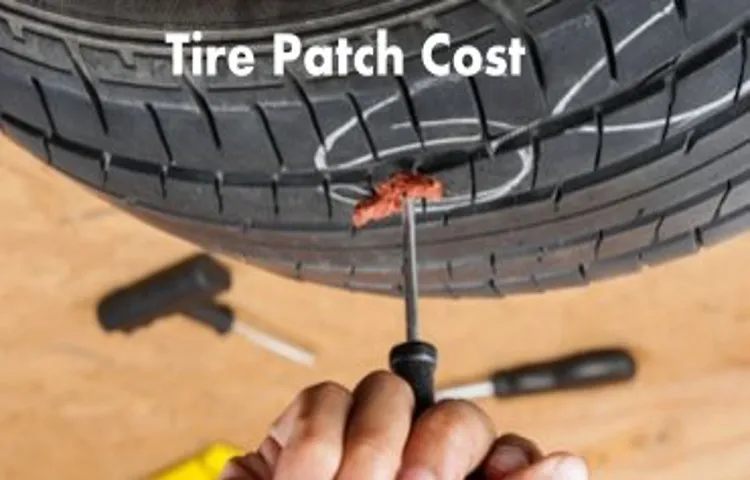Are you wondering about the cost to patch a tire? Maybe you’ve noticed a pesky flat, or you’re simply curious about the prices associated with this common automotive issue. Well, fear not! In this guide, we’ll break down everything you need to know about the costs associated with tire patches, so you can feel confident and informed the next time you’re faced with a flat. First, it’s important to note that the cost to patch a tire can vary depending on a few different factors.
One key factor is where you go to get the patch done. Different auto shops and mechanics may charge different rates for this service, so it’s worth doing some research to find the best deal. Additionally, the size and location of the puncture can impact the cost.
If the puncture is in a tricky spot or is particularly large, it may require a more specialized patch, which can cost more. With that said, on average, you can expect to pay anywhere from $20 to $40 for a tire patch. Of course, this is just a rough estimate, and your specific cost may differ.
Some places may charge as little as $10, while others may charge upwards of $70 or more, depending on the circumstances. It’s also worth noting that in some cases, a tire patch may not be possible or practical. If the damage is too severe, it may be recommended that you replace the entire tire instead of trying to patch it up.
This can obviously be more expensive than a simple patch, with costs ranging anywhere from $100 to $300 or more. Overall, the cost to patch a tire is relatively affordable, as long as you go to a reputable mechanic and address the issue promptly. By doing so, you can avoid more costly repairs down the line, and keep your vehicle running smoothly and safely.
Table of Contents
Factors that Affect the Cost
If you’re wondering how much it costs to patch a tire, there are several factors to consider that can ultimately impact the price. One of the most important factors is the type of vehicle you have, as larger and heavier vehicles will generally require more expensive tires than smaller vehicles. Additionally, the location of the tire and the severity of the damage can also affect the cost, as more difficult-to-reach areas may require more time and effort to fix.
Another factor to consider is the type of patch that’s used, as some patches may be more effective than others but may also come with a higher cost. Finally, it’s worth noting that the cost of a tire patch may also vary depending on where you go to have the work done, as different shops and service centers may have different pricing structures. Ultimately, the cost of a tire patch can range anywhere from a few dollars to well over a hundred depending on these various factors.
Type of tire
When it comes to purchasing tires, one of the main factors that affects the cost is the type of tire. Different types of tires are designed for different purposes, which means they come with varying price points. For example, all-season tires are designed to be versatile and capable of handling various weather conditions, so they tend to be priced affordably.
On the other hand, high-performance tires demand a premium due to their ability to handle high speeds and provide excellent handling. Off-road tires are also priced higher due to their durability and ability to handle rough terrain. Additionally, factors such as size, brand, and tread pattern can also influence the cost of a tire.
Ultimately, it’s important to consider your specific needs and driving habits when selecting a tire type to ensure you’re getting the best value for your money.

Location of the damage
When it comes to determining the cost of repairing a damaged vehicle, the location of the damage is a significant factor. A minor scratch or dent on the exterior may be easily repaired with a touch-up paint job at a relatively low cost. However, larger dents or damage to the car’s frame can require more extensive repairs and expensive replacement parts.
Additionally, damage to the engine or other mechanical components can cause expenses to skyrocket. Collision repair shops will also vary in their pricing based on the location they are located, with urban areas typically having higher costs. Overall, the location of the damage plays a significant role in determining the overall repair cost, so it’s essential to get an accurate estimate and choose a reputable repair shop to ensure your vehicle is fixed right without overpaying.
Severity of the damage
When it comes to repairing your home or office, the severity of the damage will have a significant impact on the cost of the job. The extent of the damage will determine how much labor, time, and materials are required to restore the property to its former state. For example, if your property has sustained significant structural damage, such as a collapsed ceiling, the repair costs will be much higher than if you had a small leak.
Another factor that affects the cost of repairs is the cause of the damage. If the damage was the result of natural disasters or other unforeseeable events, it may be covered by your insurance policy. However, if the damage was caused by neglect or improper maintenance, you will likely be responsible for the full cost of the repairs.
Other factors that can influence the cost of repairs include the age and condition of the property, the complexity of the job, and the location of the property. Ultimately, it is best to consult with a professional to get an accurate estimate of the repair costs for your specific situation.
Average Cost of Tire Patching
If you find yourself with a flat tire, the cost to patch it can range from $10-30 per tire on average. The exact price will depend on the type of vehicle you have and the severity of the damage to the tire. A simple nail puncture can typically be patched for around $10-15, while a larger puncture or sidewall damage may require a more extensive repair and cost closer to $30.
It’s important to remember that tire patching is generally a temporary fix and may not always be possible depending on the location and size of the puncture. In some cases, a new tire may be necessary to ensure your safety on the road. Regular tire maintenance, like checking for proper inflation and rotating tires, can help prevent the need for costly repairs in the future.
National Average Cost
When it comes to getting your tire patched, the national average cost can vary depending on a few factors. On average, the cost for a tire patch ranges from $10 to $30 per tire. However, this cost can increase if there is any damage to the tire that requires more than just a simple patch.
The type of vehicle you have can also impact the cost, as larger tires require more work and materials. It’s important to get your tire patched as soon as possible to avoid further damage and a potentially more costly replacement in the future. So, don’t hesitate to bring your car in if you suspect a puncture – a quick fix can save you money in the long run!
Cost Variations by Region
When it comes to tire patching, the average cost can vary greatly depending on the region. For example, in urban areas with high costs of living, the price for patching a tire may be significantly higher than in rural areas with lower expenses. Additionally, the overall cost may be influenced by factors such as local competition, taxes, and equipment costs.
It’s essential to do your research and compare prices from different repair shops in your region to ensure you’re getting the best deal. While the average cost may differ from location to location, it is worth noting that the cost of patching a tire is generally much cheaper than having to replace it entirely. It’s always better to address the issue as soon as possible to avoid further damage and extra expenses down the road.
DIY vs. Professional Tire Patching
When it comes to repairing a punctured tire, you may be wondering if it’s best to tackle the task yourself or leave it to a professional. The cost of patching a tire varies depending on whether you choose to do it yourself or bring it to a tire shop. DIY options typically cost less, but require specialized tools and experience to properly patch the tire.
On the other hand, professional tire patching services may cost a bit more, but ensure a safe and effective repair. While DIY patching may save you money in the short term, a poorly executed job can lead to further damage and potentially dangerous driving conditions. It’s important to weigh the cost and convenience of each option and choose accordingly, considering factors such as your own experience and skill level, as well as the severity of the puncture.
Ultimately, ensuring a secure and reliable tire repair should be your top priority.
DIY Patches
If you’re faced with a flat tire, the decision whether to handle the patch job yourself or take it to a professional can be a tough one. DIY patches can be relatively simple and cost-effective, but it’s important to understand the caveats. Professional patches, often costing more, offer reliability and insurance to guarantee longevity.
Before taking on the task, make sure you have all the necessary tools and the level of expertise required to do the job properly. Additionally, remember that a DIY project can expose you to additional risks, such as an increased risk of injury and additional vehicle damage, while professional patching offers a warranty that protects you in the long run. The best approach is to weigh the benefits and risks of the two options and determine what makes the most sense for your needs.
Professional Patches
When it comes to fixing a tire puncture, there are two options: DIY or professional patching. DIY patching kits can be convenient and cost-effective, but they may not provide a long-lasting solution. Professional patches, on the other hand, can be more expensive, but they are more reliable and can extend the life of your tire.
The key advantage of professional patches is that they are typically vulcanized, meaning they provide a more permanent seal by chemically bonding the patch to the tire. This process requires special equipment and expertise, which is why it’s best left to professionals. While DIY kits can be a quick fix, they may only provide a temporary solution, and you may end up having to replace the tire altogether.
In the end, it’s a matter of weighing the cost and convenience of DIY patching against the long-term benefits of professional patching. In our opinion, investing in a professional patch is worth it for the peace of mind knowing your tire will be fixed properly and safely.
Final Thoughts
If you find yourself with a punctured tire, you might be wondering how much it will cost to patch it up. The cost of tire patching can vary depending on a few different factors. Firstly, the severity and location of the puncture will affect the price.
A small puncture in the center of the tread will likely cost less than a large puncture on the sidewall. Additionally, the cost can vary based on where you take your vehicle for the repair. A tire repair shop might charge a different price than your dealership or an auto parts store.
On average, it can cost anywhere from $10 to $40 to patch a tire. It’s important to address a puncture as soon as possible, as driving on a flat or low tire can cause further damage and be dangerous. Overall, the cost of patching a tire is a small price to pay for the security and safety of your vehicle and passengers.
Conclusion
When it comes to patching a tire, the cost really depends on various factors such as the size and location of the puncture, the type of tire, and even the region you live in. While you could take the DIY route with a patch kit, it’s generally recommended to have a professional handle the task for optimal safety and longevity. So, in conclusion, the answer to ‘how much does it cost to patch a tire’ can only be accurately determined by taking your tire to a trusted mechanic.
Because as they say, it’s better to be safe than sorry – and with a well-patched tire, you’ll certainly be cruising safely and worry-free.”
FAQs
What is the average cost of patching a tire?
The average cost of patching a tire ranges from $10 to $30, depending on the size and severity of the puncture.
Can all punctured tires be patched or do they need to be replaced?
Generally, punctures that are less than ¼ inch in diameter and located on the tread’s center can be patched. Larger or sidewall punctures may require tire replacement.
How long does it take to patch a tire?
Patching a tire usually takes 15-30 minutes, provided the damage is not extensive and the mechanic is skilled.
Is it safe to drive on a patched tire?
Yes, if the patch is done correctly, it is safe to drive on a patched tire. However, it is essential to monitor the tire’s air pressure and have it checked regularly by a professional.
Can a tire be patched more than once?
It is generally not recommended to patch a tire more than once. This is because the tire’s structural integrity may have weakened after a previous repair, making it more susceptible to a blowout.
Does insurance cover tire patching costs?
Some auto insurance policies cover tire repairs, but it depends on the type of coverage purchased. It’s best to check with your insurance provider to determine if tire patching is covered.
What are the signs that a tire needs to be patched?
Some signs that a tire needs patching include low air pressure, a hissing sound indicating air leakage, and visible damage such as a nail or object sticking out of the tire. It’s crucial to get the tire inspected as soon as possible if any of these signs are present.



